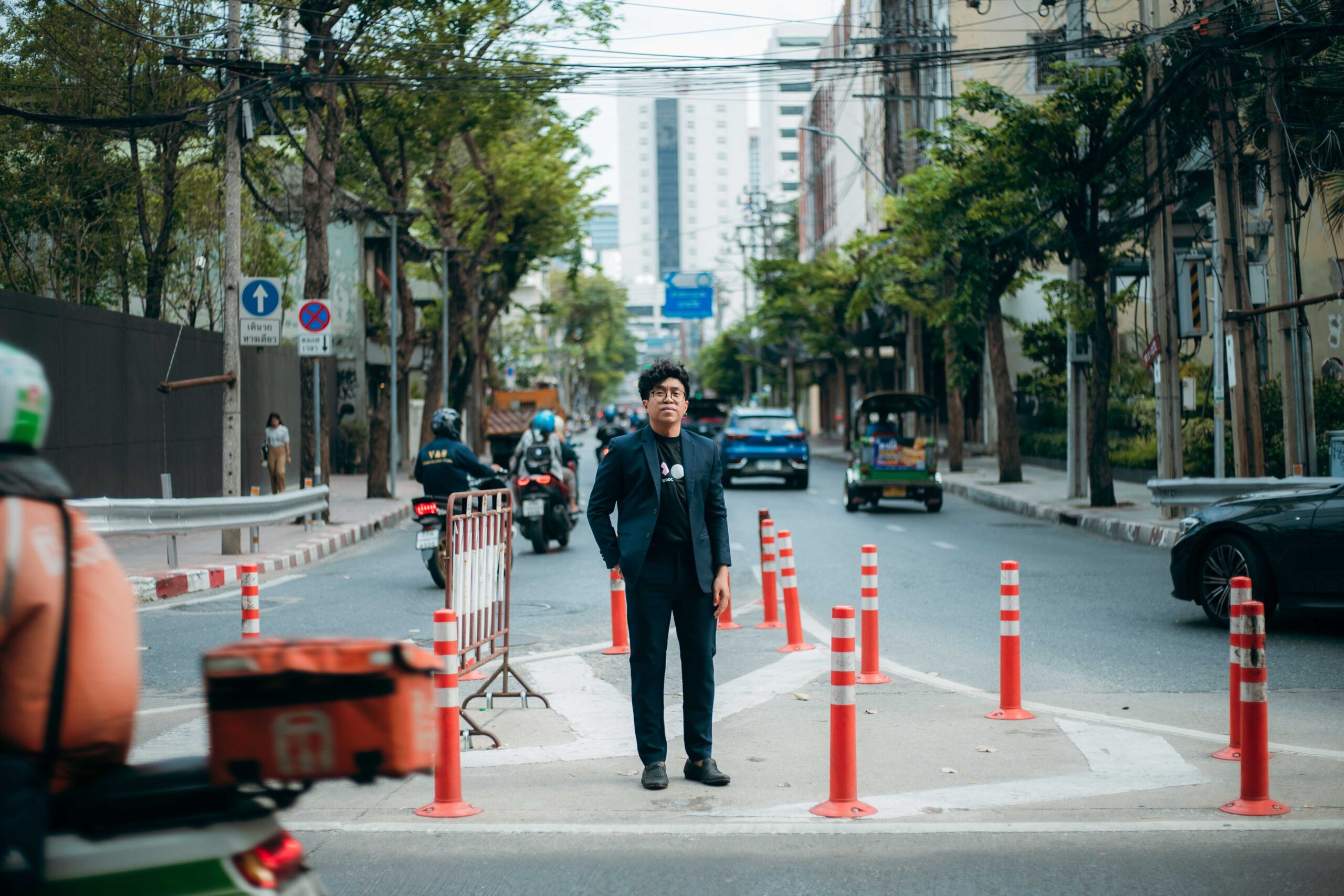‘What time do most people start and finish work, and how much time do they have for other activities?’
‘What kinds of spaces do big cities provide? Are there only workspaces, or are there a diverse range of spaces for people to relax and unwind?’
‘How do the elderly in the four major cities live? Are their life activities spread throughout the city, or do they stick to just familiar neighborhoods?’
The above questions are examples of what the ‘Dynamic Cities via Mobility Data’ Project has contemplated on. Rooted in Big Data, this project aims to study the ever-evolving lifestyles and cities in the hopes of creating positive changes. Overall, it interestingly stands out in the three following aspects:
Firstly, it marks the first time Thailand has used Mobility Data or data from people’s cell phones for public benefits by means of acquiring insights into the dynamics of four cities and their residents’ lives. These four cities are Bangkok, Chiang Mai, Khon Kaen and Songkhla’s Hat Yai.
Secondly, it utilizes data from the Telco-Tech industry for urban development. In this project, True has managed data while UddC is responsible for insightfully analyzing data to develop better urban development approaches.
Thirdly, it offers people, policymakers, and relevant parties the opportunity to explore, study, and comprehend data that is presented in easy-to-understand manner on websites. Additionally, the project creates forums for them to exchange opinions to gather and develop better ideas and perpetuate positive changes at all levels.
Let’s learn more about this project via an interview with Adisak Guntamueangleee, Deputy Director of the Chulalongkorn University’s Urban Design and Development Center (UddC) and the head of the project’s panel on in-depth analysis of mobility data in urban context. He talked about efforts behind the scenes and the focus on developing inclusive cities.
Data and the Needs for Urban Studies
“Cities are not merely fixed structures. They are dynamic. They are always interacting with people and evolving,” Adisak explained about the nature of urban spaces.
As an urban data scientist, often referred to as a ‘spatial data alchemist,’ Adisak believes that in-depth data holds the key to acquiring comprehensive understanding of the cities. His employer UddC specializes in urban research and data analytics. Thanks to its expertise, UddC has contributed to many prominent urban development projects such as Walkable Cities Project, Good Walk Project and Prapokklao Sky Park Project. Furthermore, the center shares various urban stories on The UrbanIs website.

Adisak said in the past, urban studies relied on traditional data sources such as census statistics, surveys, or observations. These methods had limitations in terms of quantity and accuracy and could be likened to “still photos” of the past that failed to reflect the rapid and hectic changes of cities in the modern century.
“Population census data, which is updated every 10 years, or other types of data that take months—or even years—to collect can become outdated by the time they are used. Field data collection, such as surveys, requires months to complete, and if additional data is needed, the whole process must start over. Not only that the approach takes so much time, but it may also fail to present the real-time realities of urban life,” the expert pointed out.
Today, one of the most powerful tools for understanding the complex, ever-changing nature of cities is Mobility Data or population movement data collected from mobile devices. “It allows us to visualize patterns of movement, travel behaviors, and the distribution or concentration of people across different areas and timeframes in real time. When combined with geographical and physical data, it provides a much more precise reflection of urban dynamics,” said Adisak.
However, the use of Mobility Data must be carefully managed to uphold privacy. “Our project uses anonymous data. It is presented in grids as summarized proportions, without identifying any individual. Urban management only requires mass-level data or overall conclusions. Importantly, adhering to ethical standards in data usage is a professional responsibility,” Adisak emphasized.
Diverse Lifestyles in Towns
At the heart of Dynamic Cities via Mobility Data Project are the analyses of Mobile Data and Mobility Data from cell phones. True manages cell-phone users’ anonymous data, both directly and indirectly, in accordance with not just its stringent Privacy and Cybersecurity policies but also personal data protection law.
The integration of Mobility Data into the project, which seeks insights into cities in the hopes of improving their residents’ quality of life, has multiple benefits as follows:
Real Behavioral Insights: Mobility Data provides empirical evidence of urban behaviors, reflecting real-life decisions. This reduces biases and errors while revealing trends in how people interact with urban spaces over different time periods.
Accurate & Real-Time Data: Mobility Data offers high accuracy and continuous real-time updates, allowing immediate tracking of how people use their urban spaces over different time periods.
Ready-to-Use for Urban Planning: Mobility Data can be directly used for city planning and design. There is no need to waste time converting data or making forecasts based on historical statistical data.
Faster & Broader Data Collection: It is possible to continuously gather data from large populations across all areas, offering a macro-level overview of urban conditions while allowing selective use of data for specific study topics.
“Our access to the telecom industry’s Mobility Data is groundbreaking, because it enables the utilization of the business world’s data for urban development. This is a pilot initiative that will spur the use of Mobility Data for various other purposes such as town management, disaster responses, adaptations to emerging changes, as well as forecasts that will allow proper preparations for any scenario,” Adisak said.

Space, Time and Generational Behaviors
Data alone is not enough to explain urban phenomena. For deeper and meaningful insights, urban concept framework must also be clear. As UddC has expertise in this field, Adisak clearly explained the framework across three dimensions as follows:
Spatial Dimension: It is necessary to identify key space types used by city residents. There are three types: the space for their living, the space for their education or work, and the space for their visit such as the places for dining / sightseeing. Based on these types, three major concepts of activities in cities are Creativity, Mobility and Consumption.
Time Dimension: Analyses must look into how people spend their 24 hours in a day and what activities they engage in. The “8:8:8″ principle should apply, because it supports a balanced life.
Urban Behavior Dimension: This allows insights into the behaviors of city people in different age groups – those in educational years, those in the working-age group, and those in retirement. How do they live in their cities?
“When these conceptual frameworks are analyzed together, they reveal challenges faced by urban dwellers. For instance, work behaviors in the four major cities are different. In Bangkok, working for eight to 10 hours a day is the norm, with many people still at work or in their workplace’s vicinity at around 7 or 8 PM. When combined with other data, we can see why Bangkok’s working people do so. Some may continue to stay in their office to avoid traffic congestion during rush hours, while others may decide to eat before heading home because of their long commute. In contrast, in the other three cities, employees typically finish work by 5 PM, thus having time to enjoy their personal lives after work.” Adisak presented interesting findings.
Data-Driven Public Policies
“For urban planners, these insights can be used to propose or formulate more precise solutions,” said Adisak, citing examples of how his project’s findings have inspired public policies.
“Our study shows most Bangkokians start working at 10 AM, while people in Chiang Mai and Khon Kaen usually begin working at 8 AM. When cross-referenced with commuting data, this suggests that Bangkok residents often travel longer distances to work, face traffic congestion, or intentionally avoid rush hour. This insight has led to the idea of developing neighborhood hubs or the ’15-minute city’ policy, enabling residents to get to work and access essential services in their local areas. Therefore, their commute time reduces, and they have more time for the lives they want,” Adisak continued,
“There is also a generational dimension, which reveals that the elderly tend to stay within their own neighborhoods and do not venture out into other public spaces. This correlates with environmental factors that hinder travel, such as streets and sidewalks that are unfriendly to users and prone to causing accidents. Based on these insights, there is a policy-driven initiative for the ‘Walkable City.’ Under this project, infrastructure is enhanced, and public spaces are expanded to allow the elderly to leave their homes and experience the city comfortably and safely, supported by public facilities designed for walking,” Adisak explained.

Cities Matter to Everyone
Because cities affect everyone, ‘Dynamic Cities via Mobility Data’ Project seeks to spark discussions and share ideas by inviting members of the general public to explore and study data through a website designed with easy-to-understand visualizations. Once browsing to the website, people can access a quiz to reflect on their own lives before delving into the broader picture of their cities.
Now, let’s think about this. ‘Do we design the city, or does the city design our lives?’
“There is no conclusive answer to these questions. They are just like ‘Which came first, chicken or eggs?’ But in principle, cities and people influence each other. For example, if a city is designed with more sidewalks than roads, this physical structure naturally encourages people to walk more. Conversely, people’s behaviors can reshape the city’s structure. If people enjoy frequenting shopping malls, their demand will naturally prompt the market to construct more malls. Alternatively, if there is a demand for exercise spaces, the city will adapt to accommodate that,” Adisak said.
“Although there is no definitive answer, it is clear that people and cities influence one another. While cities shape our lives, we also have the power to design the kind of city we want to live in,” Adisak concluded.
_______
Watch the clip ‘Do we design the city, or does the city design our lives?’
Explore insights from ‘Dynamic Cities via Mobility Data’ Project at https://www.true.th/blog/data-playground/dynamic-cities/
Join the conversation at Data Playground for Human Impacts — a collaborative community dedicated to leveraging data to drive positive social change and create a better future for all: www.facebook.com/groups/dataplayground/









